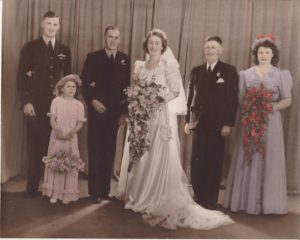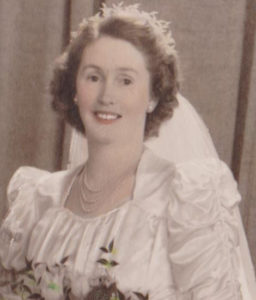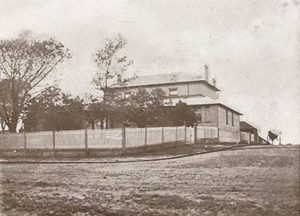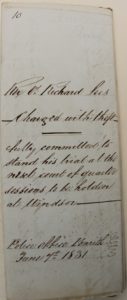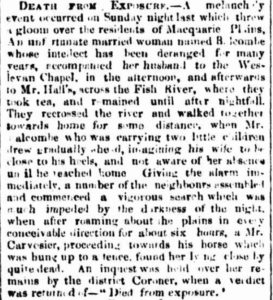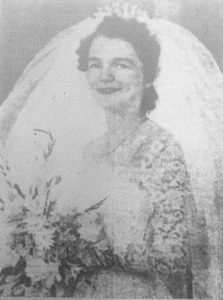Joseph Davidson was born and grew up in the hamlet of Kilgrammie in the parish of Dailly. Kilgrammie is about two miles below the village of New Dailly. The area is surrounded by the Girvan Valley coalfield. New Dailly, the village, was created in the 1760’s as a coal mining village[1].
Dailly Church and Churchyard
Joseph’s parents were James Davidson and Margaret McMurtie they were married in New Dailly and lived there most of their lives. New Dailly had been built at the expense of John Hamilton of Bargeny, who paid for the town to be built so as to encourage traffic to move further away from Bargany House[2]. The hamlet of Kilgrammie was in a beautiful location with ruins of castles and the old village of Dailly nearby and also some stunning countryside. However, the village itself was very limited. A description from 1913 of the area detailed the houses that had been in the hamlet at the time that the Davidsons had lived there.

Marriage of James Davidson and Margaret McMurtie 1761 Dailly. Scotlands People. Parish Registers 585/ 10 428
There is one dry-closet of two compartments, one of which had no door, and ashes and filth were strewn around. There is no ash-pit, no coal-house, and of course no washing house.
The single houses measure 16 feet by 11 feet. The double house measures- kitchen 14 feet by 9 feet, the room 18 feet by 10 feet.
The floors are of brick tile, very badly broken.
The coals are kept below the bed, and the washing is done in the middle of the floor. One woman, we saw in a one-apartment house doing her washing there. A wet winter day, an abominable path into the house, a floor littered with dirty clothes ready for the wash, made a picture which one is almost ashamed to think about.
The houses are very damp, and much of the plaster is badly broken. All of them need repair.
The fronts are unpaved and filthy. All around were ashes, filth, and broken glass, with the other rubbish which one sees in an ash pit. … The whole row is a pollution[3].
Although the description is dire, it is also more than a 100 years after the Davidsons were living in this area. The size of the cottages would not have changed in that hundred years but the level of repair would have and the expectations of a family.
James Davidson was a servant with William Crawford, a Coal Grieve, at Bargany, the manor house near to Dailly. The Coal Grieve was the manager of the Coal Pit. At this time coal miners and their families were bound to the colliery and the owner of the colliery. Gradually during the latter 1700’s, well after James and Margaret were married the emancipation process began to free colliers and miners. Without the 1775 Act of Parliament allowing miners and their families to become free of their owners, the Davidsons would never have been able to leave the mines of Dailly or change their profession. They would also never have been able to look forward to an education.
Bargany House, Dailly, Ayrshire, Scotland.
At the time of the emancipation act James Davidson was 37 years old[4]. This meant that he had to serve 7 years from the date of the act, before he was allowed to leave the Colliery and find work with another mine or elsewhere if he chose. With James’ freedom would come that of the younger members of his family. Any children already working in the mines would have to serve their term before they too, and their families, could become free. However, this possibility set in motion events that would change the Davidson family and eventually bring many of them to Australia.
With the freedom to choose his own career, after the Emancipation Act James and his children were also free to decide where he would live. James remained for the rest of his life in Dailly, but his son Joseph, and Joseph’s family moved to Auchinleck, sometime between 1824 and 1831. Auchinleck was also a small mining town but it was close to other towns with a wider variety of employment opportunities. The town was larger than Dailly and situated close to other towns that employed skilled craftsmen.
Auchinleck.
Despite these options, Joseph, like his father before him, stayed in mining. Joseph married twice, first to Janet Welch. This first family resulted in five children. However, less than two weeks after the birth of her youngest son, James, Janet died. Leaving Joseph with five children under the age of 6 in his care. Given the timing of Janet’s death, it is probable that she died of Puerperal fever, often as a result of an infection due to incomplete expulsion of the placenta after birth. Puerperal fever is an extremely painful infection that creates a sepsis throughout the entire body of the sufferer usually resulting in death[5].

Baptism of Joseph Davidson. Scotland’s People. Old Parish Registers Births 585/ 10 208 Dailly
John Davidson did not stay in the family profession of mining. Instead, like many people in the Auchinleck area of Scotland, John Davidson went into box manufacturing. The Auchinleck area was just starting to become well known for the quality of its snuff boxes. In particular, a hinge developed by William Crawford, not known if he is related to the William Crawford that James Davidson was a servant of in the 1760’s, was very popular because it was hidden. This hinge defined the quality of the early snuff boxes from the Auchinleck area[6].Left with five young children and no way to care for them while he was working in the mines Joseph married Agnes Walker less than 18 months after the death of his first wife. Unlike Janet, Agnes survived the birth of eight children and went on to live to the age of 80, well past the death of her husband. Janet also got to experience, at first hand, the changes in the lives of the Davidson family.
By the time of the 1841 census, John Davidson was calling himself a box manufacturer. Just 10 years later John Davidson was not just a box manufacturer, he was a manufacturer employing 14 workers[7]. John Davidson and Sons seem to have been established around the time of the census, in 1851. The firm was first listed in the Mauchline Post Office Directory for 1851 as Clark, Davidson and Co[8]. By 1855, John Davidson had entered a partnership with Robert Wilson, calling themselves Davidson and Wilson. The firm referred to themselves as “Manufacturers of Scottish snuff boxes, cigar and razor cases”. The next year they had added “Scotch plaid designs upon leather etc” to their catalogue.
Mauchline Post Office Directory 1851.
Within a couple of years, the company had diversified further, creating a selection described as “articles of Scotch fancy woodwork”. By 1864 they were the “patentees of an improved application of photographs” for the transfer work on their “fancy boxes”. The firm was by this stage well established and well known, although not as big as W and A Smith, the other main manufacturer of what was later to become known as Mauchline Ware, in Mauchline. The firm became large enough to attract other investors and manufacturers and with the addition of Samuel Amphlet, the company became known as Davidson, Wilson and Amphlet.
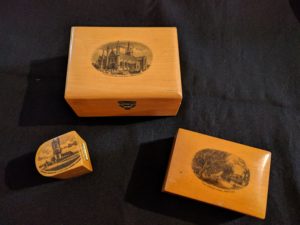
Mauchline Ware Items. Authors Collection
In 1867 John Davidson left the firm, which then became known as Wilson and Amphlet. Davidson started his own company, John Davidson and Sons. In particular, this new company included John Davidson and his sons Joseph, William and George. John’s remaining children were too young to participate in the running of the company.
The inventory of John Davidson and Sons expanded further into tartan ware and a diverse range of other souvenirs. However, over the next five years, the family were to experience a number of personal tragedies, including the loss of the wives of both George and William Davidson. Then John, himself, only lived for five years after the formation of the company. When he died his three eldest children, Joseph, George and William maintained the business until around 1889 when the business folded[9].

Kellys Post Office Guide 1862- Scotland
Davidson and Sons provided the finances that enabled the remaining Davidson boys to receive an education, giving them opportunities that earlier members of the family would never have been able to dream of.
After the closure of Davidson and Sons in 1889 Joseph and William continued in the industry but no longer running their own company. George disappears from the records at this stage and may well have either immigrated or died. David Davidson, the fifth child became an Engineer and immigrated to Australia. Alexander Boyd Davidson died in 1870. John Davidson is missing from the records and Robert Davidson, like his older brother David, immigrates to Australia. Of the girls Jane and Agnes, Jane also disappears from the records. Agnes married Alexander Gibson Alexander and has a large family. Alexander also works in the timber business as a wood turner.
Rise of the Davidson Family Part 1
[1] (Dailly (New Dailly), South Ayrshire, 2016)
[2] (Paterson, Facsimile Reprint 2001)
[3] (Scottish Mining, 2017)
[4] (Scottish Mining, 2017)
[5] (Burch, 2009)
[6] (Brooke, n.d.)
[7] (Davidson, John. 1851 Census, Scotland, 1851)
[8] (Mauchline, 1851-1852)
[9] (Trachentenberg & Keith, 2002)
Bibliography
(1856, September 4th). Retrieved August 27, 2017, from Scotlands People: https://www.scotlandspeople.gov.uk/search-our-records
(1861). Retrieved August 27, 2017, from Ancestry.com: ancestrly.com.au
(1883, August 31). Retrieved August 27, 2017, from Scotlands People: https://www.scotlandspeople.gov.uk/search-our-records
Brooke, B. (n.d.). Mauchline Ware still a mystery to many. Retrieved from Bob Brooke Communications: http://bobbrooke.com/mauchlinware.htm
Burch, D. (2009, January 10). When Childbirth Was Natural, and Deadly. Retrieved from Live Science: https://www.livescience.com/3210-childbirth-natural-deadly.html
Dailly (New Dailly), South Ayrshire. (2016). Retrieved from Gazatteer for Scotland: http://www.scottish-places.info/towns/townfirst1106.html
Lang, D. (1905). Centenary History of the Presbyterian Church in New South Wales. Sydney: S. T Leigh and Co. Retrieved September 26, 2017, from https://archive.org/stream/centenaryhistory00came/centenaryhistory00came_djvu.txt
Laws relating to Coalworkers in Scotland. (1609- Act). Retrieved from Hood Family and Coal Mining: http://www.hoodfamily.info/coal/law1606act.html
Laws Relating to Coalworkers in Scotland. (1775 Act). Retrieved from Hood Family and Coal Mining: http://www.hoodfamily.info/coal/law1775act.html
Paterson, J. (Facsimile Reprint 2001). History of the Counties of Ayr & Wigton Scotland. Maryland, UK: Heritage Books.
Records of Trinity College, college of theology, Glasgow, Scotland. (n.d.). Retrieved from Jisc: https://jisc.ac.uk/
Robert Davidson. (1979, September 24). Port Macquarie News.
Scotlands People. (1851). Retrieved from National Records of Scotland: https://www.scotlandspeople.gov.uk
Scottish Mining. (2017). Ayrshire Housing Part 5. Retrieved from Scottish Mining Website: http://www.scottishmining.co.uk/135.html
Scottish Mining. (2017). Early Mining History. Retrieved from Scottish Mining Website: http://www.scottishmining.co.uk/8.html
Scottish Post Office Directories. (1851-1852). Retrieved from Scottish Post Office Directories: http://digital.nls.uk/86566307
Trachentenberg, D., & Keith, T. (2002). Mauchline Wate: A collectors guide. Suffolk: Antique Collectors’ Club Pty Ltd.

